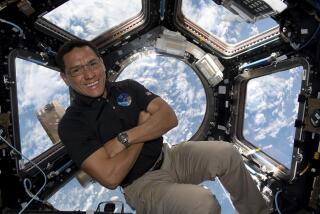Hot-Air Balloon Distance Record Is Challenged
- Share via
Claims to a world distance record in the flight of a manned balloon across the Pacific last month have been questioned by a man who made a similar flight in 1981.
Final calculations indicated that Britain’s Richard Branson and Per Lindstrand flew the hot-air balloon, Pacific Flyer, on a meandering track measuring 6,761 statute miles (5,879.2 nautical) from Miyakonojo, Japan, to an unnamed frozen lake in Canada’s Northwest Territories, 200 miles north-northwest of Yellowknife.
Larry Newman of Scottsdale, Ariz., says that he, the late Ben Abruzzo, Ron Clark and restaurateur-adventurer Rocky Aoki flew the helium-filled Pacific Eagle farther in November of 1981.
“We flew 7,000 (statute) miles,” Newman said.
But he might not be able to prove it, and it didn’t become relevant until recently.
In 1981, the Federation Aeronautique Internationale in France accepted records only by the more direct “great circle” distance--the shortest distance from point to point, without considering the wind-blown meanderings of a balloon.
Measured that way, Newman’s flight from Nagashima, Japan, to Covelo in northern California was recorded officially as 5,208.67 statute miles (4,526.3 nautical).
Lindstrand estimated that, using that system, his and Branson’s flight would have been 4,764 statute miles (4,143.4 nautical).
“We both are right--and we both are wrong,” Lindstrand said.
It will be up to the FAI to decide. Carl Stefan of Ft. Collins, Colo., the American delegate to the FAI and head of the International Ballooning Committee, said the process could take several months.
Stefan said that the FAI’s “sporting code” adopted several years ago--after Newman’s flight--allowed for the cumulative measurement of the legs of a balloon’s zigzag route if the route was verified by sufficient checkpoints. “If a balloon does some wandering, it can use those checkpoints,” Stefan said.
Lindstrand said that he and Branson had 20 checkpoints and doubted that Newman had any to verify his claim of 7,000 miles.
“His navigation system was quite primitive at the time,” Lindstrand said. “And he flew a fairly constant latitude.” Lindstrand’s Pacific Flyer flew a southerly course near Hawaii, then turned sharply northward toward Alaska and finally veered into the Territories.
Stefan expects the FAI to forward the matter to his committee for a recommendation.
More to Read
Sign up for Essential California
The most important California stories and recommendations in your inbox every morning.
You may occasionally receive promotional content from the Los Angeles Times.













